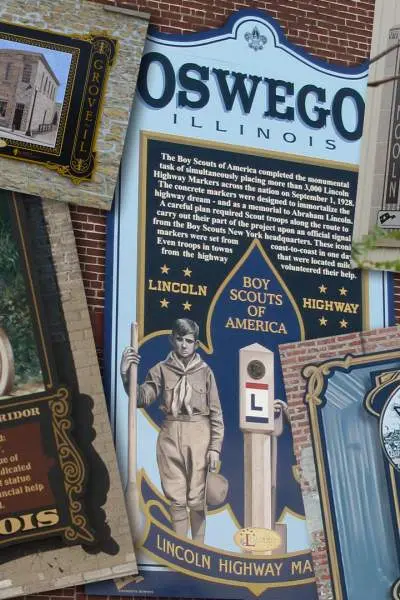
The Lincoln Highway – US-30 for much of its way across northern Illinois – was born when Midwest visionaries saw the need for a New York-to-San Francisco route.
In 1914, crews poured the first concrete, creating a marvel beside the rutted paths that defied early motorists. Now, I-80 and I-88 parallel almost all of the 179-mile route through Illinois.

Frankfort
A thriving Chicago south suburb ranked as one of the nation's fastest growing suburbs by Forbes Magazine.
Specialty and antiques shops occupy well-kept Victorian-era buildings downtown. Stop in The Family Hearth General Store for old-time penny candy. The restored Trolley Barn, which once housed a tram that followed the Lincoln Highway, includes a children’s museum and a cafe with an outdoor patio.

Joliet
A stop by Louis Jolliet and Jacques Marquete in 1673, Joliet is now the third largest city in Illinois.
Straddling the Des Plaines River, the limestone-clad downtown buildings recall a prosperous past forged on steel production. Highway travelers follow a winding path through town. The road passes the Rialto Square Theatre, a restored movie palace, as well as Harrah’s Joliet Casino and Hotel, with on-site restaurants The Reserve and Flavors the Buffet. Joliet anchors the northern end of the I&M Canal, a mid-1800s water route from Lake Michigan to the Mississippi River. In nearby Lockport, you’ll discover a path for biking and hiking that follows the old canal.

Aurora
One of the most progressive towns in the history of Illinois, the state's first free public school district was established here in 1851.
Dubbed the City of Lights in 1881 after becoming the first town anywhere to illuminate its streets with electricity, Aurora still sparkles along the Fox River. In 1914, the first street lamps along the Lincoln Highway shone here. The route now weaves through town on one-way streets, clearly marked with Lincoln Highway signs. Along the way, it passes architectural treasures, including commercial buildings Frank Lloyd Wright disciple George Grant Elmslie designed. On the modern end of the spectrum, Chicago Premium Outlets features more than 170 name brands including Coach, Ugg, Hanna Andersson and Vera Bradley.

Batavia
Many of Batavia's limestone factory buildings that were used to make majority of the windmill operated pumps once essential throughout America's farms are still in use today as government and commercial offices
The byway heads north as Illinois-31 to the heart of the Fox River Valley. This stream meanders through gently rolling farmlands and towns rich in 19th-century character. In Batavia, Victorian homes line a string of riverside parks, and seven historic windmills catch the breezes along the river.

Geneva
A town rich with history, Geneva has more than its fair share of stories to tell.
Meticulously preserved homes in 19th-and early-20th-century architectural styles line the scenic byway as it rambles north. More than 100 specialty shops and boutiques crowd along the business district’s tree-shaded streets. The Herrington Inn and Spa, a posh historic hotel beside the Fox River, pampers guests in style.

DeKalb
Named in honor of Johann de Kalb, a decorated German war hero who served in the American Revolutionary War, DeKalb is a town that shows its classic character.
The tricolored Lincoln Highway signs mark Illinois-38 as it meanders west. Settle back and savor country scenery on the way to this vibrant college town. You can stop and stretch your legs on the tree-shaded campus of Northern Illinois University. Galleries, trendy coffee bars and specialty shops mingle with hometown restaurants and other businesses in early-1900s downtown buildings. Explore the historic Egyptian Theatre, a one-of-a-kind example of 1920s style.

Rochelle
80 miles west of Chicago, the railroad industry is alive and well.
Fill up with byway information at the old-time Standard Oil Filling Station, restored as a visitors center. Then, head for Railroad Park, southwest of downtown, where the main lines of the Burlington Northern, Santa Fe and Union Pacific cross. Beside that intersection, an open-air observation pavilion rises 20 feet. Railroad buffs picnic as they watch 120 iron horses a day that lumber past. A visitors center in the park sells conductor hats, railroad uniforms and signs.

Franklin Grove
A small town of just over 1,000 with tangible Lincoln family history.
Signs lead travelers through this quiet farm town to a restored 1860 general store, which a distant cousin of Abraham Lincoln built. The two-story limestone building now houses the Lincoln Highway Association’s National Headquarters. Inside, you’ll find all sorts of memorabilia, including old road signs, photographs and reprinted guidebooks. An original Lincoln Highway signpost marks the entrance.

Dixon
Where Lincoln joined the Illinois militia, this town has seen the likes of a few presidents.
Still Illinois-38, the byway rolls into the factory town along the Rock River where Ronald Reagan lived as a child. Visitors glimpse the former president’s early years at his boyhood home. With its wide front porch and simple furnishings, the modest white clapboard two-story recalls the 1920s. You can also visit the Lincoln Highway Interpretive Center downtown. Just south of the Rock River, the Lincoln Highway meets the Blackhawk Trail. A six-mile side trip north along the river on Illinois-2 leads to Grand Detour and the impeccably restored John Deere Historic Site. A white picket fence surrounds the rebuilt 1840 blacksmith shop, whitewashed home and a prairie laced with walking trails.

Morrison
The railroad sparked the growth of this city in the 1850's.
The byway dips and curves through rich farm country before following US-30 into this agricultural community’s solid-brick business district. Dine at The Forest Inn Restaurant and Lounge, serving Greek saganaki (flaming cheese) as well as an extensive variety of steaks and seafood.

Fulton
Just on the banks of the Mississippi, Fulton is named for the inventor of the steamboat, Robert Fulton.
Signs route visitors through the small downtown to a nine-story windmill. Built in Holland, the landmark proclaims Fulton’s Dutch heritage. Climb to the top for Mississippi River views. You also can stroll a path on the levee.

